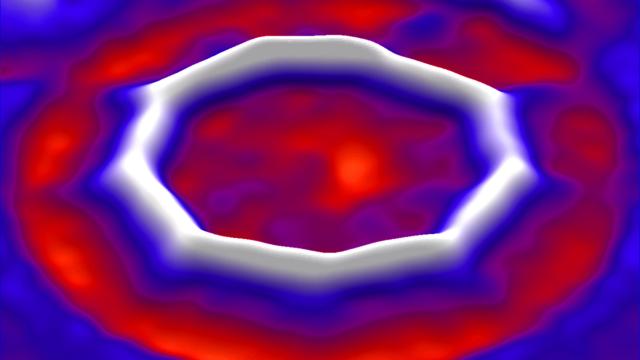Some precision chemistry performed atop a slice of table salt has given researchers unprecedented views of a controversial form of carbon.
Scientists at Oxford University and IBM have produced a ring consisting of just 18 carbon atoms using a tool called atomic force microscopy. Researchers have long speculated about the properties of this ring but had only been able to produce it in a gas without studying its properties. This new creation helps put the mystery surrounding some of these properties to rest.
The structure of these molecules “was a debate for the last 50 years,” Przemyslaw Gawel, the study’s corresponding author and a researcher at Oxford University, told Gizmodo in an email. “This is the first example where the structure is revealed.”
Substances made from solely carbon come in various flavours, or allotropes. You’ve heard of diamonds, where each carbon atom connects to four other carbon atoms in a network. Graphite is carbon arranged into stacked, two-dimensional sheets, and graphene is a single layer of graphite. The scientists were hunting for an allotrope called a cyclocarbon, specifically cyclo[18]carbon which consists of 18 carbon atoms. (You may have heard of benzene or aromatic rings — these differ from carbon allotropes because benzene rings also have hydrogen atoms attached to each of their carbon atoms.)
Scientists have long been hunting for cyclocarbons, hoping to figure out what their structure was like. Specifically, they’ve been interested in how the carbons bond together — whether each carbon bonds to its neighbour with two electrons, or whether each bonds with a single electron to one neighbour and three electrons to its other neighbour in an alternating fashion.
A group then at UCLA and another at Osaka and Tokyo Metropolitan Universities in Japan synthesized the molecule in a gas phase in the late 1980s and 90s, respectively. But while those results were “tantalising,” the teams couldn’t determine which bond organisation the rings had, according to the paper published today in Science. Plus, the rings are difficult to work with. Their bent carbon bonds make them extremely reactive , causing them to coalesce into other carbon structures.
Creating the molecule on top of a surface so they could actually study it was hard work. Gawel had attempted, unsuccessfully, to synthesise the rings using several different approaches. PhD student Lorel Scriven eventually joined the lab and worked on creating precursor molecules, the carbon rings but with extra molecules attached to add support.
The Oxford team shipped the molecules to IBM, where the IBM researchers used a method called atomic force microscopy to knock the scaffolding off of the molecules held on a salt surface at super-cold temperatures. Atomic force microscopy probes molecular surfaces based on their interaction with the microscope’s tiny tip. But researchers can also apply voltage pulses to the tip in order to alter the molecule’s structure.
Against all odds (study author Katharina Kaiser from IBM told Gizmodo that the precursors exploded a few times, and that the pulses could break the precursor molecules), the researchers were able to create the ring and solve the mystery. The carbon bonds were arranged in alternating single and triple bonds.
“Seeing the first picture of C-18 and all the chemistry I had been working on for months come together was a really rewarding experience. I immediately sent a picture to [Gawel],” Scriven told Gizmodo.
As study author Leo Gross from IBM emphasised, this group was not the first to synthesise the cyclo[18]carbon — each study author credited Francois Diederich’s team with making it first (Diedrich declined to comment on this story).
As for what you might do with these molecules, the answer is in basic science: to figure out how to make more of them, including bigger rings, more easily. But, said Gross, they might eventually be useful in computer technology as an extremely energy-efficient computer logic device. Like graphene, these rings potentially have exciting electronic properties, said Scriven.
It typically goes this way — one problem is solved, and now it’s on to the next one.
